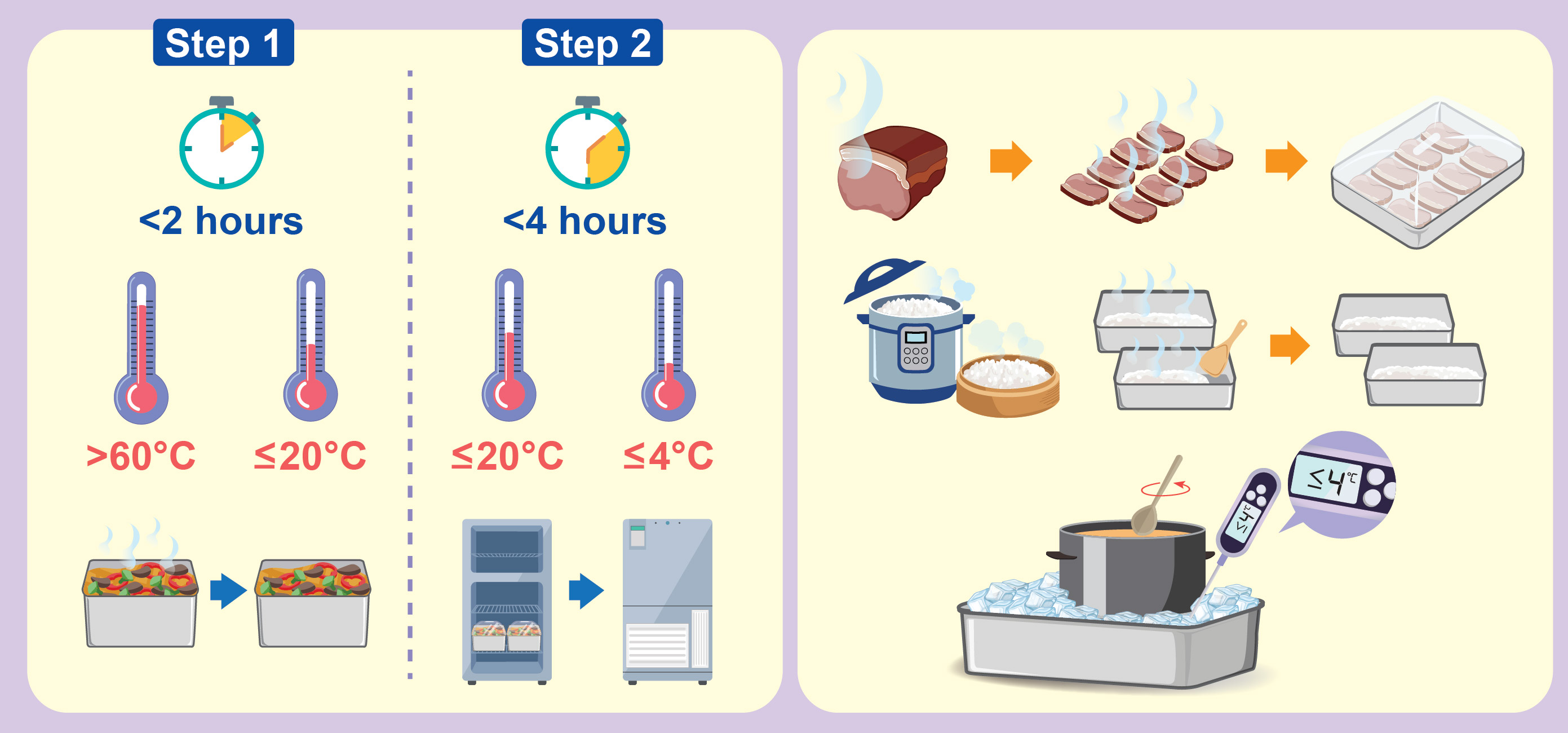
Food Safety Focus (206th Issue, September 2023) – Article 2
Ensuring Food Safety: Proper Cooling, Defrosting and Reheating
Reported by Ms. Bibiana YUEN, Chief Health Inspector,
Risk Assessment Section, Centre for Food Safety
The risk of food poisoning increases during the summer season because bacteria grow faster in warmer weather. Proper temperature control throughout various stages of food preparation, including cooling, defrosting and reheating is essential in preventing food poisoning. In this article, we will present important food safety concepts that members of the public and food businesses should pay special attention to, including the Temperature Danger Zone, proper cooling techniques, as well as key points on defrosting and reheating.
What is Temperature Danger Zone?
The Temperature Danger Zone refers to the range of temperatures where bacteria can rapidly multiply in food, increasing the risk of foodborne illnesses. This zone typically ranges from 4°C to 60°C. Harmful bacteria can grow in food that is left at dangerous temperatures. Sometimes, these bacteria can produce heat-resistant toxins, which cannot be destroyed even by reheating. Therefore, it is crucial to minimise the time that food stays in the Temperature Danger Zone to prevent bacterial multiplication, spore germination and the formation of heat-resistant toxins that can cause foodborne illnesses. Food safety risks can be reduced by cooling food quickly and storing it at proper temperatures after cooling.
Cooling Food – Best to Make It Fast
Prepared food that will not be consumed promptly should be cooled properly. Proper cooling can reduce the time that food is exposed to the Temperature Danger Zone, and hence minimise the risk of bacterial growth. In general, a Two-Step Cooling Approach can be used for the cooling of food. First, cool the food from its cooking temperature to 20°C within two hours. Then, cool the food from 20°C to 4°C or below in a refrigerator within the next four hours (Figure 1). To speed up the cooling process, it is preferable to cut the food into smaller pieces or spread it out in shallow, covered containers in an area with good air circulation.
Some food business operators may opt to use specialised equipment such as blast chillers to quickly lower the temperature of hot food to a safe temperature at or below 4°C within 1.5 hours. Such cooling technique can further reduce the time of food being exposed to the Temperature Danger Zone. When blast chilling is done, food should be stored in refrigerators or freezers.

Figure 1. Two-Step Cooling Approach and Techniques of Speeding up Cooling
Defrosting – Better to Thaw Food at Safe Temperatures
Even though food is frozen at 0°C and below, some harmful bacteria present in the food may still be alive but just inactive. Once frozen food is thawed, its core temperature will rise and bacteria may start to be active again and multiply. Defrosting food appropriately is therefore important to avoid the growth of harmful bacteria.
Proper food defrosting can be achieved by using a refrigerator set between 0°C and 4°C, running cold tap water or a microwave oven. The preferred method for keeping food safe is to defrost frozen food in the refrigerator. If refreezing is necessary, defrost food by using refrigerators as food will be consistently kept out of the Temperature Danger Zone during defrosting. Do not defrost food at room temperature, as this exposes the food to dangerous temperatures for an extended period of time, promoting bacterial growth.
Reheating – Key to Secure Food Safety Before Consumption
Reheating precooked food means cooking again, not just warming up. When reheating food, similar to cooking, ensure that the core temperature of the food reaches at least 75°C for 30 seconds and then serve it at a proper hot holding temperature at above 60°C (Figure 2). Avoid refrigerating the food after reheating because bacteria can grow if it stays at dangerous temperatures for too long. Of note, do not try to heat food using equipment like a bain marie or other devices designed solely for keeping food hot. This may take too long or fail to heat the food adequately to keep it safe.

Figure 2. Reheating and serving food at proper temperatures
Maintaining proper temperature control throughout the various stages of food preparation is fundamental to ensuring food safety. Implementing effective cooling, defrosting and reheating procedures are essential practices that could minimise the risk of foodborne illnesses. Proper record keeping for temperature monitoring at each stage is also important as it ensures food preparation occurs at safe temperatures and helps to evaluate the performance of hot-holding and chilling equipment, which is vital for maintaining food safety standards. Equally significant is providing comprehensive training to staff members, equipping them with the necessary knowledge and techniques relevant to their specific roles. Ongoing training plays a pivotal role in skill development for safely handling food.

